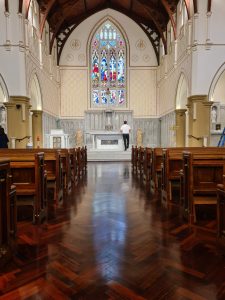In 2022 and 2023, We Love Parquet were involved in the restoration of original Parquetry flooring and wood sanding of a large heritage parquetry floor in St Peter and Pauls Cathedral Located in Goulburn NSW.
The Cathedral was built between 1870-1891 and is heritage listed in NSW.
In 1927 the Cathedral had a renovation and Jarrah hardwood Parquetry floors were installed.
The interior has been described as follows:
“On entering the Bourke Street door, the visitor beholds an unbroken space of 141 ft long by 33 ft wide. On either side of the nave there are aisles 75 ft by 14 ft, the aisles being divided from the nave by slender moulded columns of Victorian bluestone from Malmsbury. An arch at the end of the aisles opens into the transepts, which are 33 by 30 feet. A corresponding arch on the opposite sides leads to two small chapels. The roof is sealed with wood divided into bays, and under the principals there are large traceried spandrels of timber resting on columns with caps and bases, these again resting on moulded corbels, all done in keen cement. The ceiling between the principals is divided into three panels, with a different description of wood in each and again relieved by beads and scotias of other and different woods.” (Carolyn Cox)
The floor is extremely rare and is an excellent example of the types of Parquetry flooring being manufactured and installed from 1912-1930s. To give context a number of state government buildings were being built around that time such as the Post Office building in Martin Place, the Art Gallery of NSW heritage section, the Commonwealth bank building No. 5 Martin Place which has a remarkably similar floor. 



The Cathedral floor presents as an excellent surviving example of single species herringbone parquetry.
There is an unassuming block border to the perimeter which has the Tasmanian Oak specie.
The floor specie is Jarrah and the floor is a tongue and groove. It is an Australian manufactured hardwood parquetry floor in imperial block size.
Adhesives: The adhesive used is Bitumen.
The bitumen adhesive has mostly given up and has been pulverised into a fine dust which will if ever exposed, need to be isolated and treated like asbestos. The floor will need to be vacuumed regularly to remove fine particles that could come to the surface of the floor.
The scope of works was to remove Vinyl tiles, mill Parquetry blocks to size and repair flooring in all areas of the Cathedral.
We also repaired and lacquered all the Pews in the cathedral which was quite a job, and sanded and wood lacquered the floor in two stages with a modified oil which was a task as the overnight temperature was 2 degrees.
Overall, we flooring professionals have a responsibility to preserve and maintain rare and heritage floors. Let’s ensure that future generations look at the floors we are doing now with the awe with which we regard our old floors now.
Have you worked on heritage flooring, either Parquetry or Floorboards before?
How old was that floor? Did you play some part in saving the floor?

